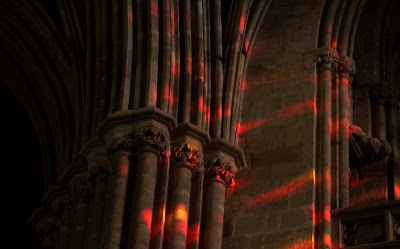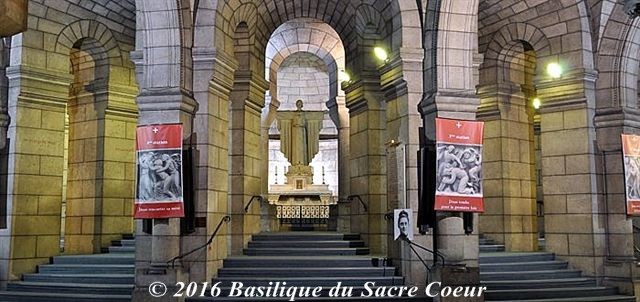Saint Therese of the Child Jesus
of the Holy Face
Entries in Therese of Lisieux (24)
June 6, 2023: the English text of Pope Francis's speech about St. Therese in the presence of her relics at St. Peter's Square
To read the full English text of Pope Francis's speech about St. Therese, courtesy of America magazine, please visit https://tinyurl.com/popefrancisjune62023
Dr. Frances Renda, the friend of Therese, has entered into life on June 17, 2019
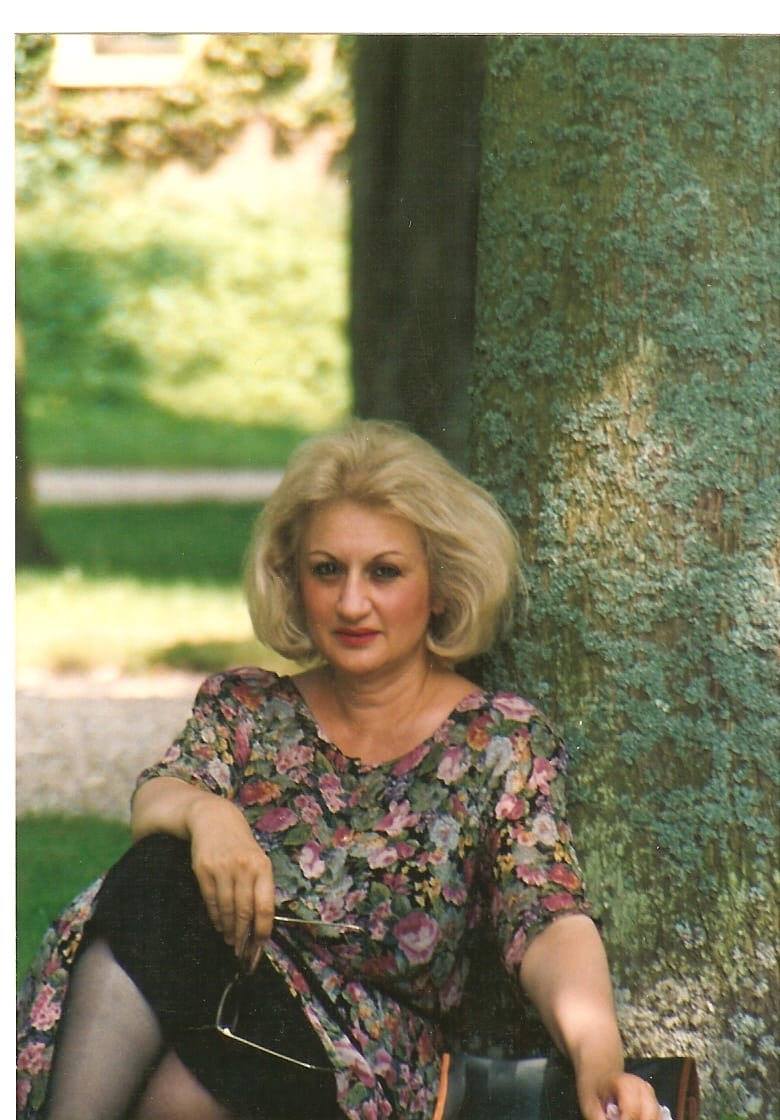 Dr. Frances Therese Renda Photo credit: Sue Princiotto
Dr. Frances Therese Renda Photo credit: Sue Princiotto
It is with the greatest sadness that we announce the sudden death, on June 17, 2019, of Dr. Frances Therese Renda, the best friend St. Therese ever had. Sue Princiotto announced her sister's death in these words:
Family and friends, it is with great sadness that our family announces the passing of Fran Renda, suddenly and peacefully in her sleep. I apologize for posting the news this way, but I wanted to make sure everyone hears before the funeral.
Please join us in paying last respects to Dr. Fran Renda on Tuesday, June 25th from 7:00 to 9:00 in the evening at The Frank E. Campbell Funeral Chapel, located at 1076 Madison Avenue in New York City.
On Wednesday, June 26, there will be a Funeral Mass held at 10:00 am at the Church of St. Joseph of the Holy Family (405 West 125th Street - NY, NY), led by the beloved Father David Nolan.
Immediately following the Mass, all are welcome to remain at the Church for a reception in honor of Fran where you are encouraged to share stories, travel tales, and fondest memories as a celebration of her distinguished, admirable and exceptional life.
At 3:00pm the same day (June 26), a burial service will be held at St. John's Cemetery (80-01 Metropolitan Avenue - Middle Village, NY). All are welcome.
I will write a personal tribute to Fran later. Here I merely share some of the highlights of her long and generous apostolate for St. Therese. Fran fell in love with St. Therese when she first visited Lisieux at the age of sixteen, and, for the rest of her life, during a distinguished career as a clinical social worker and psychotherapist, never stopped trying to make Therese known and loved. I met her in 1988 at a symposium offered by the Carmelite Province of the Most Pure Heart of Mary in Darien, Illinois to celebrate the centenary of Therese's entrance. We saw each other at conferences and other events devoted to St. Therese. Fran had taught Therese in the seminary at Yonkers, and she also taught Therese to a group of women at St. Patrick's Cathedral. They were so moved by what Fran communicated that in the 1990s, every day for seven years, they operated what was known as the "Therese desk" just inside the entrance of St. Patrick's Cathedral, offering for sale the best books and most beautiful medals of St. Therese. A dizzying number of thousands of dollars worth of books were sold, and countless souls were brought to Christ.
Fran was the moving spirit behind several important books about Therese and about the Martin family. The first to appear was "Therese of Lisieux and Marie of the Trinity," by Pierre Descouvemont translated by Fran's friend, Alexandra Plettenberg-Serban, which appeared in 1997:
It is not widely known that Fran was the catalyst for the conversation that resulted in the visit of the reliquary of St. Therese to the United States in the autumn of 1999. I was present in when Fran's group and her friends at the Cathedral made the visit of the reliquary of St. Therese to St. Patrick's Cathedral a unique grace. The memory of those happy days will never leave me.
For years Fran encouraged her friend, Bishop Patrick Ahern, in the writing of his boook "Maurice and Therese," which appeared in 2001.
In 2005, "I Thirst: Saint Therese of Lisieux and Mother Teresa of Calcutta," translated by Fran's friend, Alexandra Plettenbrg-Serban, appeared in English.
Fran edited for publication the letters of Louis and Zelie Martin, the parents of St. Therese, which were translated by her friend, Ann Hess, and published in 2011:
In connection with the publication of A Call to a Deeper Love, Fran was interviewed by Bill O'Donnell, host and producer of Spirituality TV in Santa Fe, New Mexico, where Fran several times presented about St. Therese and the Martin family:
On January 15, 2012, Fran appeared on EWTN's Sunday Night Prime to discuss Sts. Louis and Zelie Martin:
Again, shortly before the canonization of the Martin spouses, Fran spoke with Jay and Fr. Robert Reed of the Catholic TV Network about them:
For some years before Fran's death, she and Ann Hess had been collaborating again, this time on the monumental work "Therese de Lisieux," a long biography of Therese by Fran's dear friend and mentor, the late Bishop Guy Gaucher, O.C.D.
On June 9, 1897, the second anniversary of her Offering to Merciful Love, Therese wrote to Maurice Belliere words that might serve as Fran's farewell to us:
Dear little Brother, there are many things I would like to make you understand now that I am at the door of eternity, but I am not dying; I am entering into life, and all that I cannot say to you here below I will make you understand from the heights of heaven.
What happened in the life of St. Therese of Lisieux on June 11, 1895?
The Cathedral of the Immaculate Conception at Sees
Photo credit: L'Instantane
Many people know that on Trinity Sunday, June 9, 1895, St. Therese was suddenly inspired to offer herself "as a victim" to the Merciful Love of God, "asking this Love to consume me incessantly, allowing the waves of infinite tenderness shut up within You to overflow into my heart, that thus I may become a martyr of Your love, O my God!" It's slightly less well known that, within moments of making the offering, Therese was inspired to share it with those around her.
On the morning she received the inspiration and spontaneously offered herself, she was in choir. It seems that whether this happened in the hour of prayer before Mass or during the Mass is not definitively known. Her sister Celine, Sister Genevieve of the Holy Face, describes what happened next:
After Mass, she took me with her to Mother Prioress; she seemed beside herself and did not say a word. When we found Mother Agnes, for it was she who was then prioress, she asked her if both of us could offer ourselves as victims to Merciful Love, and gave her a short explanation of what that meant. Mother Agnes was at a loss; she did not seem to understand too well what was going on, but she had such confidence in Sister Therese's discretion that she gave her full permission. It was then that she composed the Act called "An Offering to Love," which she carried next to her heart ever afterwards.1
When they were alone again, Therese explained more fully to Celine the inspiration she had received. During her free time that Sunday, she gathered her thoughts and put them on paper, and, on Tuesday, June 11, the two sisters met in the anteroom to Therese's cell, where the statue of the Virgin from their childhood home, the one before which they had been praying when Mary suddenly appeared to Therese and smiled at her and she was cured, had been placed. Kneeling before the statue, the two young women made the offering together. See a period photograph of that little room and the statue on the Web site of the Archives of the Carmel of Lisieux.
Therese considered the anniversary of her own Offering to be June 9; she listed June 9 in the list of "days of grace granted by the Lord to his little spouse" she placed at the end of her first manuscript. But June 11 is an important day, for it's the day she first made her offering together with her first disciple and the day she read the words of the Offering in Celine's presence.
This prayer contained the words
"Most of all, I offer you the love and merits of the Blessed Virgin, my dear Mother. It is to her I abandon my offering, begging her to present it to You."
On the same day, June 11, 1895, that Therese and Celine knelt before the statue of Our Lady of the Smile to offer themselves to Merciful Love. about thirty thousand people assembled at the Cathedral of the Immaculate Conception at Sees to offer Our Lady a gold crown with precious stones given by the people of the whole region.2 This Cathedral was bound up with the history of the Martin family. Mary appeared at Lourdes in the spring of 1858, during Louis and Zelie's engagement. After she said "I am the Immaculate Conception," their bishop raised funds all over France to build the first church in France in honor of the Immaculate Conception at Sees, the seat of their diocese, now a famous pilgrimage site. The year before Therese was born, the chapel was consecrated before a vast crowd. Every year Zelie visited the church in Sees on the feast of the Immaculate Conception, a feast on which she had received several important graces. In 1874 she brought Leonie with her3 to ask for the grace to make a good First Communion.
While the crowd offered Mary a gold crown with precious stones, the two sisters prayed "I want no other throne, no other crown but You, my beloved!" Was it a coincidence that these two different events--one so public, one so hidden--happened on June 11, 1895?
1 St. Therese of Lisieux by those who knew her, ed. Christopher O'Mahoney, O.C.D. Dublin: Veritas Publications, 1975, pp. 128-129.
2 A Call to a Deeper Love: The Family Correspondence of the Parents of St. Therese of the Child Jesus, ed. Dr. Frances Renda, tr. Ann Connors Hess. Staten Island, New York: Society of St. Paul/Alba House, 2011. CF 125, p. 160, footnote 301.
3 A Call to a Deeper Love, CF 125, p. 160, footnote 299.
On June 10, 1914, Pope St. Pius X signed the decree for the Introduction of the Cause of the future St. Therese of Lisieux

Pope Pius X in 1914
The Church in Rome gave its first recognition to the possibility of Sister Thérèse of the Child Jesus of the Holy Face becoming a canonized saint when, on June 10, 1914, Pope St. Pius X signed, with his own hand, the commission issued by the Sacred Congregation for Rites the day before, recommending to the Pope that he introduce the cause for the beatification and canonization of Sister Thérèse. The text of this decree is below:
DECREE OF THE INTRODUCTION OF THE CAUSE
OF SISTER THERESA OF THE CHILD JESUS
DIOCESE OF BAYEUX AND LISIEUX
DECREE OF THE SACRED CONGREGATION OF RITES
CONCERNING THE BEATIFICATION AND CANONIZATION OF
THE SERVANT OF GOD SISTER THERESA OF THE CHILD JESUS,
PROFESSED RELIGIOUS IN THE MONASTERY
OF THE ORDER OF DlSCALCED CARMELITES AT LISIEUX
The Servant of God, Theresa of the Child Jesus, a Professed Discalced Carmelite nun in the Monastery of Lisieux, the Introduction of whose cause before the Sacred Congregation of Rites is now in question, the youngest of nine children of Louis Stanislaus Martin and Marie Zelie1 Guerin (his wife), was born at Alenson in the Diocese of Seez on January 2nd, 1873, and two days later in Holy Baptism was given the name of Marie-Francoise Therese.
Having being carefully trained in habits of piety by the good example of all around her in her home, on the death of her mother and the removal of the family to Lisieux, as a little girl of nine years old she was entrusted by her father to the nuns of the Order of St. Benedict for her education. Her constant reading was of that excellent book ” The Imitation of Christ ” as well as of the Sacred Scriptures, both of which she made use of to further her own and her neighbour’s edification. After having been cured in a wonderful way of a serious malady by which she had been attacked, she began more ardently to yearn for the ” better gifts,” especially setting her heart on devoting herself entirely to the perpetual service of God. Accordingly her own sisters having elected to become enclosed nuns, she after returning home from school, never desisted until, her wish being fulfilled, in the year 1888 she entered the Monastery of the Carmelite nuns at Lisieux, where clothed with the religious habit, taking the name of Theresa of the Child Jesus, and having passed through her noviciate in an exemplary manner, on September 8th, 1890, she pronounced her solemn vows. Three years later being appointed to aid with the duties of Mistress of Novices, she faithfully and holily continued to discharge the duties of this office until her death. Towards the close of her 23rd year, the Servant of God being afflicted with a deadly malady of the lungs, was obliged to take to her bed. For five months having lain prostrate in consequence of the steady progress of the inroads of the disease, borne by her most patiently, she eventually passed away in the Lord on September 30th, 1897, and after all the last funeral rites had been duly carried out, she was buried in the Cemetery of Lisieux.
The fame for sanctity which Sister Theresa had acquired during her lifetime, after her death became notably so widespread and so enduring that an enquiry for the taking of evidence regarding her was set on foot by the authority of the Bishop of her Diocese. This enquiry having been brought to a close, and the evidence having been transmitted to the sacred Congregation of Rites, as soon as all preliminaries were duly carried through, at the instance of the Most Reverend Father Roderick of St. Francis of Paula, Postulator General of the Order of Discalced Carmelites, who petitioned for the Introduction of the Cause, due consideration having been given to the Betters of certain of the Most Eminent Cardinals of the Holy Roman Church, of many Bishops, as well as of the heads of Orders and Congregations of both sexes, the Most Eminent and most Reverend Lord Cardinal Jerome Gotti, the Cardinal in charge of the Cause, at an ordinary Meeting of the sacred Congregation of Rites held at the Vatican on the date mentioned below, submitted the following question for discussion Should the Commission for the Introduction of the Cause be signed in the present case, and to the given effect ?
Whereupon the Most Eminent and Reverend Fathers, the Cardinals on the sacred Congregation of Rites, after hearing the statement of the Most Eminent Cardinal in charge of the Cause, as well as the views given in writing and by word of mouth, by the Right Reverend Father Alexander Verde, Promotor of the Holy Faith, after carefully weighing the matter in all its bearings, decided that it should be written in answer : Yes, that is, that the Commission should be signed, if. approved by His Holiness. June 9th, 1914.
Later on an account of these matters having been given to our most holy Lord, Pope Pius X by the undersigned Secretary of the sacred Congregation of Rites, His Holiness giving his approval to the Rescript of the said Congregation, with his own hand was pleased to sign the Commission for the Introduction of the Cause of the Beatification and Canonization of the Servant of God Sister Theresa of the Child Jesus, Discalced Carmelite of the Monastery of Lisieux, the tenth day of the same month and year.
Fr. S. Card. Martinelli, Prefect.
* Peter La Fontaine, Bp. of Carystus, Secretary.
* Note that the Roman documents mistake the baptismal names of Therese's mother, which were, in fact, "Azelie-Marie."
(Source: The Unfolding of the Little Flower: Sanctity in Our Day, by William M. Cunningham, 1916).
This event, introducing a new phase in Therese's cause, was the culmination of many steps already taken. First, see below the events that happened before 1914:
1898
March 7: Bishop Hugonin, bishop of the diocese of Bayeux and Lisieux, approves the publication of “Story of a Soul.”
October 20: First publication of Histoire d’une Âme (Story of a Soul). 2,000 copies are printed.
1899-1900
The first pilgrims begin to visit the grave of Thérèse. The first miracles are reported.
1906: July 6. Univers publishes a story by François Veuillet saying that the Carmel is working to introduce the cause of Sister Therese at Rome.
1907: The newly appointed bishop of Bayeux and Lisieux, Bishop Lemonnier, authorizes a prayer asking for the canonization of Sister Thérèse.
October 15: Bishop Lemonnier asks the Carmelites to write down their memories of Sister Thérèse.
1908
May 26: A four-year-old blind girl, Reine Fauquet of Lisieux, is cured at the grave of Sister Thérèse
1909: January: Father Rodrigue, O.C.D. is named Postulator of the Cause; Mgr de Teil is named Vice-Postulator.
1910
March 5: the Sacred Congregation for Rites invited Bishop Lemonnier to examine the writings of Thérèse.
May-June: The Process of the Writings takes place at Lisieux.
August: The diocesan tribunal is set up at Lisieux to hear the testimony of witnesses about Sister Thérèse’s life and her reputation for sanctity.
1911
August: The hearing of witnesses is completed.
September: The process of non-cultus is held at Lisieux.
December 12: The diocesan tribunal is solemnly closed at Lisieux. The file is sent to the Sacred Congregation for Rites in Rome.
March 13, 1912: The Sacred Congregation for Rites in Rome begins its examination of the diocesan process for Thérèse.
June 9, 1914: The Sacred Congregation for Rites issued its Commission for the Introduction of the Cause of Sister Thérèse.
June 10, 1914: In one of the last official acts of his papacy, Pope St. Pius X signs the decree with his own hand. He would die on August 20, 1914.
The English text of the speech by Bishop Germain which Therese of Lisieux, a pilgrim at Montmartre, heard on November 6, 1887
The Martin family pilgrimage to the Basilica of the Sacred Heart at Montmartre: November 6, 1887
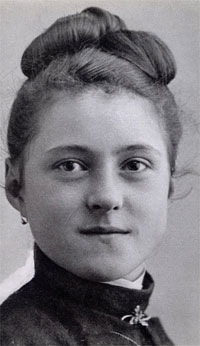 Therese in April 1888, aged 15, five months after her visit to Montmartre
Therese in April 1888, aged 15, five months after her visit to Montmartre
Today, on the anniversary of Therese's visit to the Basilica of the Sacred Heart at Montmartre, I have, thanks to the generosity of the Basilica, the joy of presenting for the first time an English translation of the speech she heard the bishop of Coutances give to the pilgrims that morning. To relive the occasion with Therese, read on:
On Sunday, November 6, 1887, the 14-year-old Therese Martin, with her father, St. Louis Martin, and her 18-year-old sister, Celine, came to the Basilica of the Sacred Heart in Montmartre, on a hill outside Paris, to assemble, together with 194 other persons with whom they were to go on a pilgrimage to Rome. The pilgrimage had been organized by the diocese of Coutances in honor of the 50th anniversary of the priestly ordination of Pope Leo XIII. It was widely seen as a demonstration of the loyalty of the French church to the Pope, who was more or less a prisoner in the Vatican, and it was covered in the French and Italian press.
Mgr Abel-Anastase Germain, bishop of Coutances. Photo credit: Wikipedia
The bishop of Coutances, Mgr Abel-Anastase Germain, accompanied the priests and lay persons from his diocese to Rome. Bishop Germain, who strongly encouraged exterior manifestations of the faith such as pilgrimages and processions, was known as an eloquent preacher. The pilgrimage was directed by his vicar-general, abbé Legroux. Therese’s own diocese, that of Bayeux and Lisieux, also participated in this pilgrimage as a diocese. Her bishop was represented by his vicar-general, Msgr. Reverony. Therese hoped that Msgr. Reverony might intercede with Bishop Hugonin to obtain permission for her to enter Carmel at the age of fifteen.
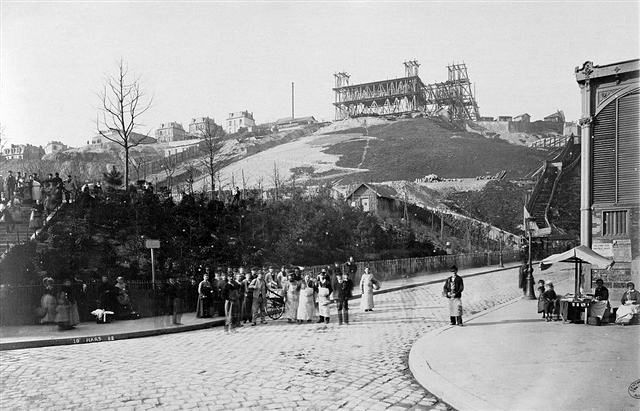 Construction of the Basilica of the Sacred Heart at Montmartre in 1882, five years before Therese arrived. Photo credit: Wikipedia.This assembly at Montmartre, where only the crypt of the basilica was completed, was the first time that all the pilgrims had come together. The Basilica of the Sacred Heart, a massive undertaking that took nearly 50 years to complete, was the fruit of a "national vow" made by the French Catholics after the defeat of France in the Franco-Prussian war of 1870. Read the story here.
Construction of the Basilica of the Sacred Heart at Montmartre in 1882, five years before Therese arrived. Photo credit: Wikipedia.This assembly at Montmartre, where only the crypt of the basilica was completed, was the first time that all the pilgrims had come together. The Basilica of the Sacred Heart, a massive undertaking that took nearly 50 years to complete, was the fruit of a "national vow" made by the French Catholics after the defeat of France in the Franco-Prussian war of 1870. Read the story here.
The Martins had arrived in Paris early on Friday morning, November 4, and Louis had spent two days showing his two youngest daughters the sights of the capital. Therese remembered chiefly visiting the Shrine of Notre Dame des Victoires, where she received an important Marian grace.
Discovering What the Pilgrims Did in the Basilica That Day
I knew that all the pilgrims had participated in Mass and other ceremonies at Montmartre on Sunday, November 6, and had been consecrated to the Sacred Heart there before leaving Paris the next morning. I had often wondered whether any record of the ceremony existed, and I wrote to the Secretariat of the Basilica at Montmartre to inquire. To my amazement, the Basilica had a copy of the November 10, 1887 issue of the Bulletin Mensuel de l’Oeuvre du Voeu National au Sacré Coeur de Jésus (Quartorzieme Annee) [Monthly Bulletin of the Work of the National Vow to the Sacred Heart of Jesus, Fourteenth Year], T. XII, No. 11. See the cover below:
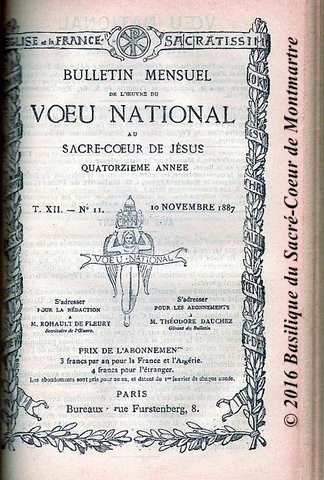 Monthly Bulletin of the Work of the National Vow to the Sacred Heart of Jesus, published November 10, 1887, four days after Therese's visit
Monthly Bulletin of the Work of the National Vow to the Sacred Heart of Jesus, published November 10, 1887, four days after Therese's visit
Recovering Bishop Germain's Speech to the Pilgrims
The November 1887 issue contained a detailed description of the ceremony and the speech, verbatim, that Mgr Germain addressed to the pilgrims. With the utmost kindness the Basilica sent it to me with permission to publish it and other illustrations. I thank the Basilica for the honor of allowing you to read the very words heard by Therese on that Sunday 129 years ago. First, see the original in French below:
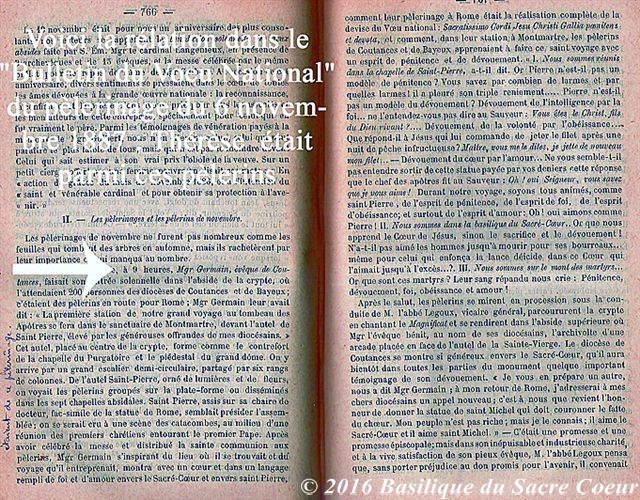
Detailed description of the ceremony and transcript of Bishop Germain's speech
Next, the English translation, which is copyright 2016 by Maureen O'Riordan. All rights reserved.
"II. November’s pilgrimages and pilgrims
November’s pilgrimages were not as numerous as the autumn leaves falling from the trees, but they made up in their importance for what they lacked in numbers.
On November 6, 1887, at 9 o’clock in the morning, Mgr Germain, Bishop of Coutances, made his solemn entry into the apse of the crypt where 200 people of the dioceses of Coutances and Bayeux awaited him; these were pilgrims en route to Rome. Mgr Germain had told them “The first station of our great voyage to the tomb of the Apostles will take place in the sanctuary of Montmartre, at the altar of St Peter, erected by the generous gifts of the people of my diocese.”
This altar, placed in the center of the crypt, in a form like the buttress of the Chapel of Purgatory and the pedestal of the great dome. One reaches it via a great semi-circular stairway shared by six ranks of columns. From the altar of St Peter, ornamented with lights and flowers, one sees the pilgrims grouped on the platform or scattered among the seven side chapels.
Statue of St. Peter, seated, at the Basilica of the Sacred Heart of Montmartre. Photo credit: TripAdvisor.
St Peter, seated at his doctoral rostrum, a facsimile of the statue in Rome, seems to preside over the assembly; one might believe oneself part of a scene in the catacombs amidst a meeting of the first Christians around the first Pope.
After celebrating Mass and distributing Holy Communion to the pilgrims, Mgr Germain, inspired by the place where he found himself, with a heart and in a language full of faith and love for the Sacred Heart and for St Peter, showed how their pilgrimage to Rome was the complete realization of the motto of the national Vow: Sacratissimo Cordi Jesu Cristi Gallix poenitens et devota ["France penitent and devoted to the Most Sacred Heart of Jesus Christ"], and how, in their station at Montmartre, the pilgrims from Coutances and Bayeux would learn to make this holy voyage with a spirit of penitence and devotion.
“1. We are gathered in the chapel of St Peter, he said. Isn’t Peter a model of penitence? You know [it] by how many tears, and what tears! He cried during his triple denial… Wasn’t Peter a model of devotions?
---Devotion of Knowledge by faith…. Don’t you hear him say to the Lord: You are the Christ, living son of God?...
--Devotion of the will by obedience… What does he respond to Jesus who commands him to toss out his net after a fruitless night of fishing? Master, you tell me and I throw out my net again.
----Devotion of the heart through love… Don’t you seem to hear coming from this statue paid for by your pennies this response made by the head of the Apostles to the Savior: “Oh, yes, Lord, you know that I love you!”
“During our voyage let us all be moved, like St Peter, by the spirit of penitence, the spirit of faith, the spirit of obedience, and above all by the spirit of love: Oh! Yes, let us love like Peter!
II We are in the Basilica of the Sacred Heart.. What shall we learn from the Heart of Jesus if not sacrifice and devotion! Didn’t he love men so much that he died for their torturers… even for the one who plunged the god-killing lance into the Heart of Him who loved him to excess?
III We are on the Martyrs' Hill… Now, who were these martyrs? Their spilled blood cries to us: Penitence, devotion, faith, obedience and love!”
Detail of the procession singing the Magnificat, November 6, 1887
After the greeting, the pilgrims organized themselves into a procession under the leadership of the Abbé Legoux, vicar general. They wandered throughout the crypt singing the Magnificat and proceeded into the upper apse [in the open air] where Monseigneur the Bishop blessed, in the name of the people of his diocese, the decorative molding of an arch placed before the altar of the Holy Virgin. The diocese of Coutances proves itself so generous to the Sacred Heart that there would soon be in all parts of the monument some important evidence of its devotion.
Procession of pilgrims singing the Magnificat, November 6, 1887
“I am preparing another one for you,” Mgr Germain told us: “upon my return from Rome, I will address my dear diocesans with a new appeal: it will be our honor to donate the statue of St Michael which will crown the pinnacle of the choir. My people are not rich, but I know them: they love the Sacred Heart. and they love St Michael.”
This was a promise, and an episcopal promise, but in his inexhaustible and industrious charity, and with the lively satisfaction of his pious bishop, Abbé Legoux thought that, without prejudice to the promised gift for the future, ……
Can We Find the Missing Page of this 1887 Article?
Here the account breaks off, for, miraculous as it is that this record has been preserved, the next page is missing. The Bulletin Mensuel, which was published from Paris, showed, in 1887, subscription prices for France, Algeria, and foreign countries. If any of you can find a copy of the November 10, 1887 edition that contains the complete account (perhaps in a library or in the archives of a religious order that subscribed), please do let me know, for I hope to publish the complete article in English and to restore it to the Basilica in French.
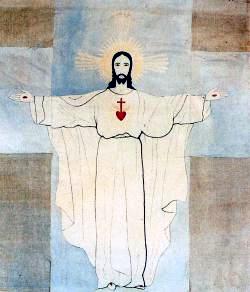 Image of the Sacred Heart of Jesus in the chapel of St. Pierre in the Basilica of the Sacred Heart at Montmartre
Image of the Sacred Heart of Jesus in the chapel of St. Pierre in the Basilica of the Sacred Heart at Montmartre
The Chapel of St. Peter at Montmartre
We know that the Martin family received Communion at this Mass at Montmartre. I believe that they participated in the Mass from the Chapel of St. Peter. Although this art was not there in 1887, that chapel today contains an image of the Sacred Heart based on the one Charles de Foucauld had in his chapel at Beni-Abbes.
The Consecration to the Sacred Heart
Before leaving the Basilica for lunch, all the pilgrims were consecrated to the Sacred Heart and given small badges of the Sacred Heart. Below is a sketch of Therese at the moment of consecration.
Therese kneeling in the Basilica at Montmartre at the moment of her consecration to the Sacred Heart
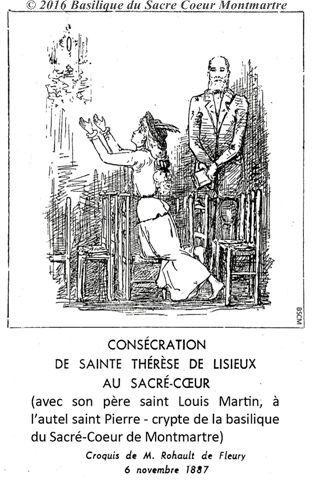
Therese wrote that she had asked for a special grace, "the grace," for her cousin, Jeanne Guerin. We do not know what this grace was. For more about the devotion to the Sacred Heart at that time and for Therese's unique experience of the Heart of Jesus, which departed radically from the accepted interpretation of the "Sacred Heart devotion," please read my article "The Abysses of Love and Mercy of the Heart of Jesus: St. Therese of Lisieux and the Sacred Heart."
A plaque on the wall near the altar of St. Peter commemorates the visit of St. Therese, Celine, and St. Louis.
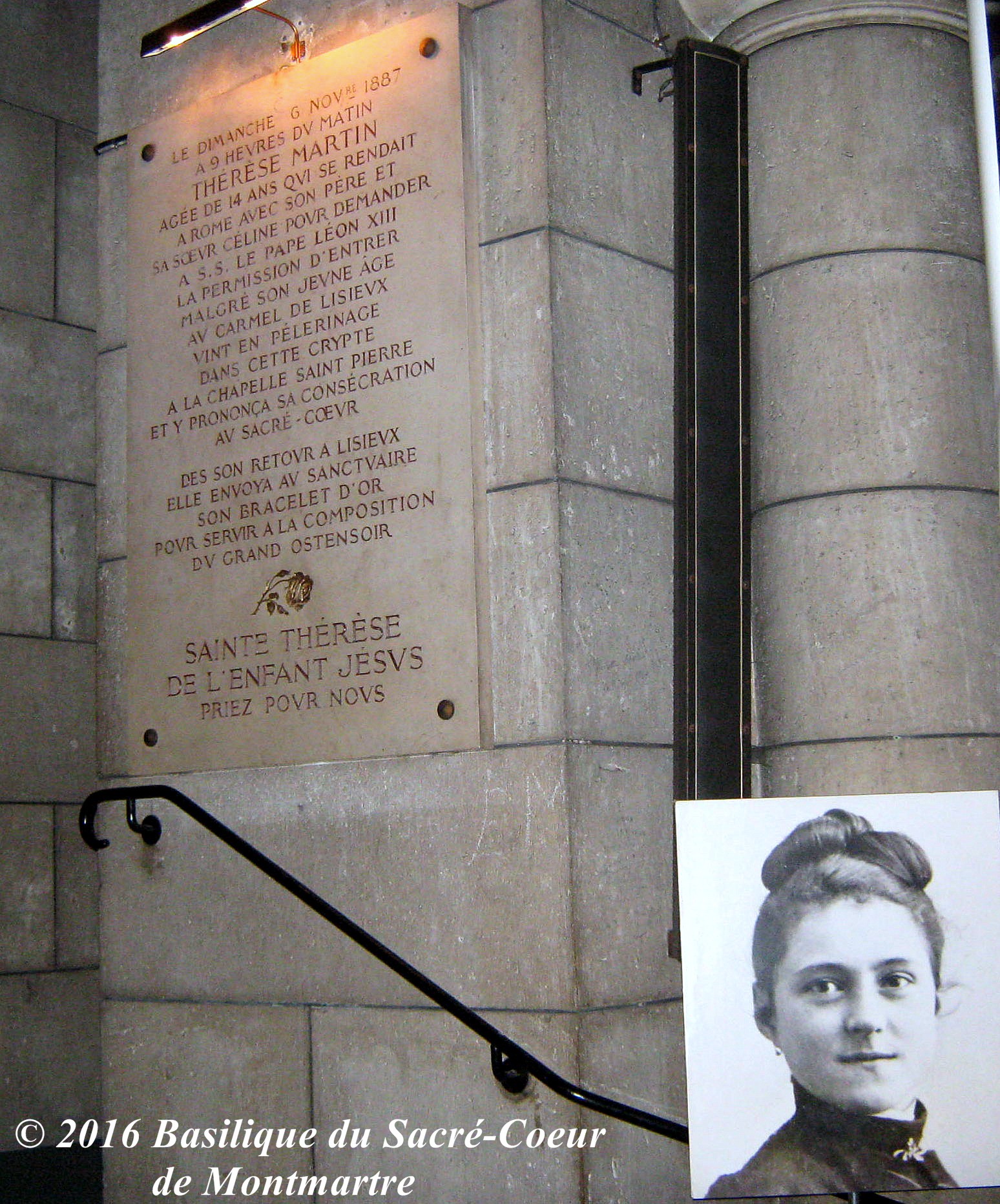
Therese Offered Her Gold Bracelet for a Monstrance for the Basilica
The plaque mentions that when Therese, the jeweler's daughter, returned to Lisieux, she sent her gold bracelet to the chaplains of Montmartre to be melted down in order to form part of the great monstrance for the basilica, a sacramental sign of her desire to keep vigil near the Eucharist day and night. That monstrance is pictured below:
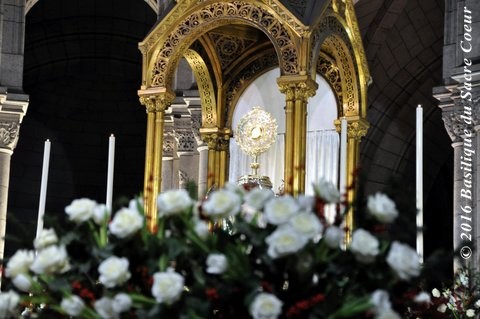 The gold monstrance for which St. Therese sent her gold bracelet
The gold monstrance for which St. Therese sent her gold bracelet
Perpetual Adoration of the Eucharist at the Basilica of the Sacred Heart at Montmartre
Perpetual adoration of the Eucharist in the basilica has continued day and night since 1885, two years before Therese's visit.
 Perpetual adoration of the Eucharist in the Basilica of the Sacred Heart at Montmartre. Photo credit: TripAdvisor.
Perpetual adoration of the Eucharist in the Basilica of the Sacred Heart at Montmartre. Photo credit: TripAdvisor.
If you go: following in the footsteps of St. Therese at Montmartre
Although Therese did not have the chance to adore the Eucharist in the Basilica at night, pilgrims now have that opportunity. If you are staying elsewhere in Paris, you can do so just by getting a ticket at a certain time in the evening that will admit you to the basilica after it closes for the night. If you are seeking a more complete retreat experience, you may stay overnight at the guest house operated by the Benedictine Sisters of Perpetual Adoration of Montmartre, whose vocation is to animate the spiritual experience of the pilgrims to the Basilica. You will have the opportunity to sign up for your chosen time of adoration. This is a powerful way to follow in the footsteps of St. Therese in Paris and also to honor her father, St. Louis Martin, and her uncle, Isidore Guerin, who were leaders in the movement of nocturnal adoration at Alencon and at Lisieux. Night and daytime pilgrimages are offered to individuals and to groups.
A Carmelite monastery on Montmartre
The friends of St. Therese will be happy to know that there is also a Carmelite monastery on Montmartre. It was founded in 1927.
I was delighted to see that the Basilica has now described the November 6, 1887 ceremony on its Web site in French.
The relics of St. Therese venerated at the Basilica of the Sacred Heart at Montmartre
Several times the relics of St. Therese have visited the Basilica of the Sacred Heart at Montmartre in November to commemorate her visit in 1887. See photos and videos of the visit in 2015. Could the devout teenage girl have guessed in 1887 that "she would return, more than a century later, in the form of relics offered for the veneration of the faithful?'
I renew my fervent gratitude to the Basilica for permitting me to share with you these precious texts and images. Please pray for the flowering of the great work of prayer and adoration that takes place there. And please add a prayer for my own ministry for the Martin family, too. If you can visit Montmartre, please share your experience there with me by clicking "e-mail me" at the left side of the Web site. Thank you.




